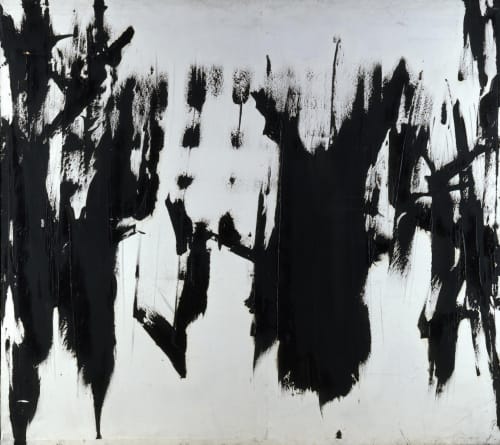Judit Reigl was born in Kapuvár, Hungary on 1 May 1923. Reigl studied at the Academy of Fine Arts in Budapest between 1941 and 1945. In 1947, Reigl procured an Italian visa to attend the Hungarian Academy in Rome, where she hitch-hiked to major towns to study the Old Masters and visited the Venice Biennale in 1948. She returned to Hungary later that year, which had been taken over by a Soviet authoritarian regime. In March 1950, she clandestinely crossed the Iron Curtain to escape the ascent of Stalinism and reached Paris, where she met the painter Simon Hantaï. He introduced Reigl to André Breton, who organised her first solo exhibition at the Étoile Scellée gallery in 1954. After this first association with the Surrealists, Reigl detached herself from the movement and started experimenting with a more individual form of gestural painting – monochrome grounds, marked with palette-knife and blade scrapings. Whilst in Paris, Reigl was reunited with Betty Anderson, and English student of Henry Moore’s whom she had first met in the 1940s in Italy, who would become her lifelong companion.
In 1963, Reigl and Anderson moved to the commune of Marcoussis. Around this time, Reigl increased the sizes of her canvases, concurrently increasing her body’s involvement with the act of painting. She would also employ found tools, from curtain rods to the faceted stopper of perfume bottles, as an extension of her body. During the 1960s and in the subsequent years, Reigl also began to depict anthropomorphic subjects in her work, as in her Man (1966-72) and Decoding (1973) series. In the 1980s and 1990s, Reigl alternated work in Marcoussis with summers in Languedoc-Roussillon, and continued to explore space and figuration with her gestural style up until her death on 6 August 2020.
Reigl's work can be found in the following selected international collections: the Museum of Modern Art (MoMA), New York; the Metropolitan Museum of Art, New York; Solomon R. Guggenheim Museum, New York; Albright-Knox Art Gallery, Buffalo; Cleveland Museum of Art; Museum of Fine Arts, Houston; Ludwig Museum, Budapest; Musée National d'Art Moderne, Centre Pompidou, Paris; Musée d'art moderne de la Ville de Paris; Musée des Beaux-Arts, Dijon; Musée de Brou, Bourg-en-Bresse; the Tate Collection, London.
Please contact the gallery for further information on this artist.
